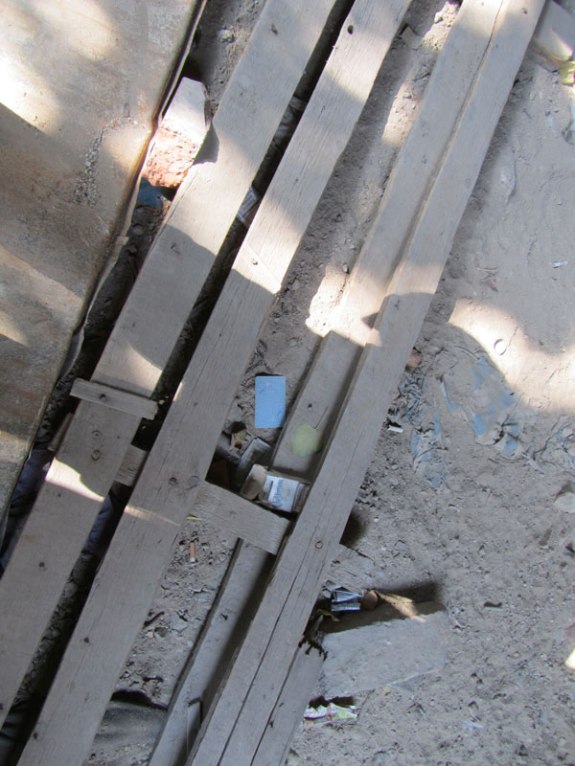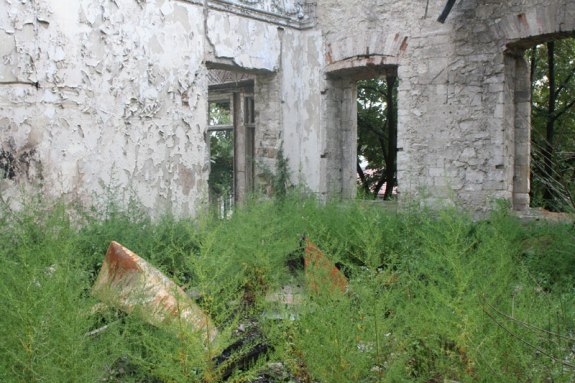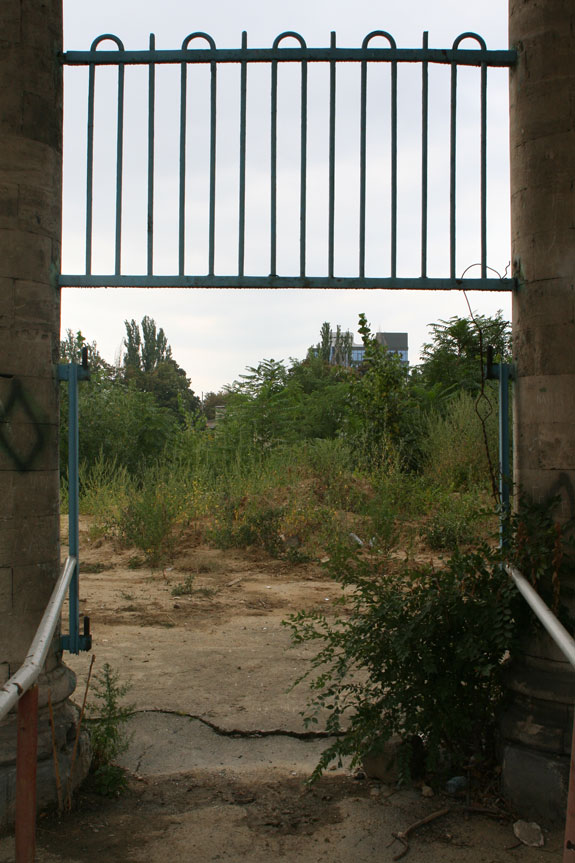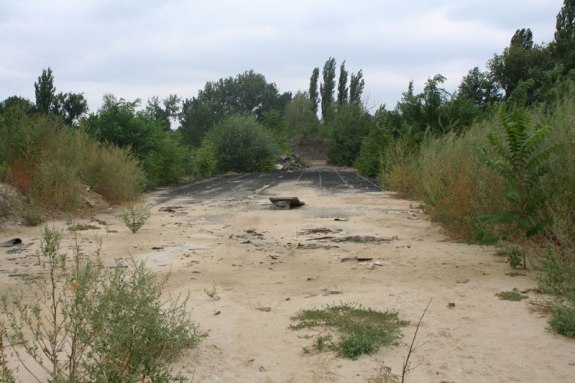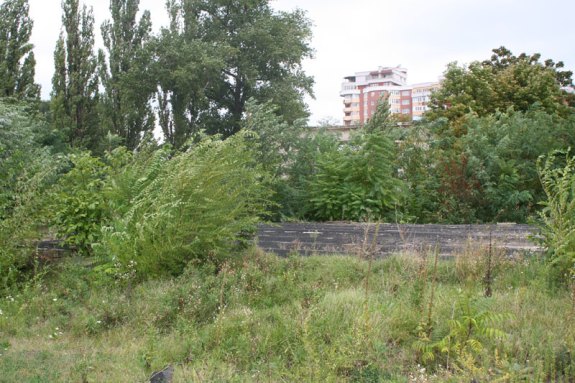– – scroll down for English version – – –
RO
– – – – –
(A fost un semi tur derive – am folosit aceste cîteva ore ca să vizitez două locuri pentru care nu am reuşit să găsesc timp înainte. Totuşi, explorarea mediului urban mi-a luat de două ori mai mult timp decât am planificat).
Am început plimbarea mea de-a lungul străzii Bucureşti, spre Stadionul Republican (astăzi demolat).
Îndată ce am părăsit Apartamentul Deschis (unde Mikheil ne-a prezentat scopul turului situaţionist al Chişinăului şi noţiunea de derive), am zărit o casă demolată în partea stîngă, chiar peste drum. Faţada casei era singurul element care s-a păstrat şi puteai privi înăuntru prin geamuri pentru a observa ruinele. Casa a fost demolată pentru a fi vândută mai uşor. De fapt, ceea ce a contat pentru propietar a fost preţul terenului, şi nu valoarea istorică sau arhitecturală a unei construcţii tipice pentru Chişinăul vechi, precum este cazul acestei case. Demolarea ei a concis cu protestele unei noi mişcări numită “Poştaşii Chişinăului”, care la acel moment făcea primii săi paşi. Astăzi încă poţi vedea pe faţada casei un număr de telefon 06801555, urmat de textul: Продам 4 сотки земли (Vând 4 ari de teren).
Am continuat să pargurg strada București. Pista pentru cicliști dispăruse sub frunzele căzute și mașinele parcate pe trotuar. Undeva la intersecția cu strada Pușkin era agățat un afiș publicitar al unui partid politic.
Am făcut următoarea oprire cu cîteva sute de metri mai departe, lîngă o altă clădire veche şi degrădată, dar importantă pentru Chişinău – casa lui Rîşcanu-Derojinschi. Arhitectul Alexandru Bernardazzi a proiectat-o în secolul XIX. În anii 50 ai secolului XX, clădirea a fost reconstruită pentru a găzdui şedinţele Prezidiului Consiliului Suprem al RSSM, iar mai târziu a servit ca sediu principal al secţiei de propagandă a Comitetului Central al Partidului Comunist, numită “Ştiinţa”. În 2009, această clădire a fost închiriată şi apoi vândută în condiţii neclare unei companii al cărei obiectiv este construirea unui hotel şi a unui centru comercial în acelaşi loc. În conformitate cu legea, propietarul unei clădiri istorice ar trebui să menţină clădirea şi să facă restaurarea necesară, condiţii care nu au fost respectate de către noul propietar – de fapt, propietarul clădirii speră că aceasta va degrada în măsura în care restaurarea nu va mai fi posibilă şi clădirea va trebui să fie demolată.
Pe scările sale am găsit nişte sticle de bere goale.
În 2008, Chişinăul a fost vizitat de un grup de artişti care au făcut diverse intervenţii artistice prin oraş şi, de asemenea, în interiorul acestei clădiri, pe care le-am văzut doar în fotografii – nişte graffiti şi colaje. De data aceasta am vrut să le văd în realitate.
A trebuit să urc prin geam pentru a ajunge în interior, locul părea abandonat şi nu foarte sigur. De asemenea, am observat diferite obiecte şi lucruri care au fost lăsate de vizitatorii precedenţi şi care m-au făcut să cred că există oameni care vizitează acest loc în mod regulat. Pe podea erau împrăștiate sticle de plastic, bucăți de metal ruginit, materiale de construcție, praf şi gunoi. Am găsit şi nişte cărţi de joc cu femei goale, fapt care conferea o anumită doză de intimitate întregului spaţiu.
Eu făceam fotografii cu câteva aparate de fotografiat simultan, când deodată am fost atacat de o haită de câini de stradă, alergând din camera alăturată în direcţia mea, patru sau cinci câini, nu am reuşit să-i număr şi nici să mă pregătesc pentru apărare. În câteva secunde am făcut doi paşi înapoi la fereastră şi am sărit afară, aterizînd cu un picior pe o mașină parcată în fața clădirii.
După câteva minute, o bătrână a venit încercînd să calmeze câinii. Fiind încă în stare de şoc, am strigat la ea să-şi ţină câinii în lanţ. Ea mi-a răspuns în limba rusă „Это их территория! (Acesta este teritoriul lor!)”.
Totuşi, am decis să continui, aşa că, după ce femeia şi câinii au plecat, am intrat din nou prin geam, înarmat cu pietre şi beţe şi m-am deplasat încet înainte. Imediat după aceasta, am auzit câinii apropiindu-se din nou şi în acel moment am aruncat cîteva pietre în direcţia lor. În plus, am început să strig şi să fac zgomot, pentru a-i speria, iar asta a funcţionat. Câinii nu au îndrăznit să mă atace pentru că riscau să fie loviţi cu pietre. Am putut continua explorarea casei din interior.
Jos am găsit un spaţiu mare, cu colonade pe ambele laturi.
De îndată ce am urcat pe scări, am găsit câteva coridoare care m-au condus spre camere diferite.
Pe un perete era un text care făcea referinţă la bibliotecă şi m-am simţit invitat să citesc cărţi.
Pe alt perete am găsit desenul unei intervenții făcute în 2008.
O altă cameră era umplută cu texte poetice scrise pe pereţi şi, de asemenea, erau haine împrăştiate pe podea.
Un alt spaţiu arăta ca o grădină adevărată, doar că sălbatică.
Am descoperit şi un pat realizat dintr-o haină veche lăsată pe jos şi am încercat să-mi imaginez cum este să dormi într-o casă fără acoperiş, privind stelele noaptea.
O ruină vie.
Acest loc mă duce cu gîndul la lucrarea My lovely Villa a lui Lukasz OBALEK, un artist polonez, care, fiind inspirat de spațiile unor case părăsite din Bytom, își propune să locuiască în ele, activîndu-le printr-un performance și recuperîndu-le astfel de la abandon.
Am luat o parte din casă cu mine, am ieşit pe stradă şi am continuat traseul spre Stadionul Republican.
Anumite lucruri îi conferă Chişinăului o identitate proprie. Aceasta depinde de detalii cum ar fi culoarea în care sunt vopsite casele, copacii, uneori oamenii.
La intersecţia cu strada Bulgară m-am oprit pentru a privi copacii plantaţi recent, ocupând un loc în care, de obicei, puteau fi văzute maşini parcate.
După aceea, am văzut un semn cu număr de stradă căzut, pe care l-am luat cu mine.
Mai aproape de Stadion, am găsit o mulţime de graffiti. Mesajele scrise concurau unul cu altul. Graffiti reprezintă unul din primele semne vizibile ale unui loc abandonat. Acolo puteau fi citite mesaje ale unioniştilor care promovau reunificarea Republicii Moldova cu România, împreună cu mesaje scrise în chirilică revendicând Chişinăul drept un oraş rusesc, precum şi nelipsita publicitate comercială.
O lună mai târziu, toate mesajele şi inscripţiile grafice au dispărut, cineva le-a acoperit cu var, tranformîndu pereții stadionului în niște picturi abstracte.
Poarta Stadionului Republican era deschisă. Cîteva maşini erau parcate în faţa ei, ocupînd spaţiul disponibil.
Când acest stadion a fost construit în 1952, a fost proiectat pentru 8000 de persoane şi era folosit pentru a găzdui meciuri de fotbal şi competiţii de atletism. Eu făceam un curs de atletism când eram adolescent şi m-am antrenat pe acest stadion, aşa că am o legătură personală cu acest loc. Stadionul a fost demolat în 2007 şi nu a mai fost reconstruit. În acest moment este greu de spus dacă va fi vreodată reconstruit un compex sportiv în acest spaţiu, o parte din care deja a ajuns în mîini private, sau altundeva în oraş.
După ce treci prin porţi, vezi un teren mare acoperit cu nisip rămas după demolare, iarbă şi copaci salbatici care deja ajung la 3-4 metri înălţime. De asemenea, poţi vedea fundamentul unei tribuni care a fost cândva acolo. Cu cât mai mult avansezi spre teren, cu atât mai utopic pare acest peisaj – în afara timpului şi în afară oricărui uz.
La un moment dat, totuşi, în mijlocul stadionului poate fi descoperită o bucată din pista de atletism, ceea ce a rămas din ea. Pista încă era acoperită cu cauciuc şi părea potrivită pentru desfăşurarea activităţilor sportive. Această zonă mică era probabil utilizată din cînd în cînd de persoane care fie se jucau cu mingea, fie mergeau pe biciclete sau skateborduri. Tot acolo am descoperit şi o trambulină dintr-o uşă metalică.
Peste terenul verde, din ambele părţi, se pot vedea construcţii noi din beton şi oţel, unele dintre ele acoperite de sus pînă jos cu oglinzi albastre, care se înalță deasupra fostului stadion. Ele anunţă schimbarea paradigmei politice şi ilustrează migrarea puterii de la statul care odată controla toate sferele vieţii, la propietarii de capital privat.
Câteva minute mai târziu, un paznic s-a apropiat de mine (de parcă ar fi fost un teritoriu privat), întrebându-mă cum am intrat – i-am răspus că poarta era deschisă, aşa că m-a lăsat să continui explorarea rămăşiţelor a ceea ce a fost cîndva un loc pentru sporturi, competiţii şi glorie pentru multe generaţii de oameni care au trăit în Chişinău.
Vladimir US
27 august 2012
– – –
acest text a fost scris în urma Turului situaționist al Chișinăului organizat la inițiativa lui Mikheil Svanidze în cadrul proiecutului SPACES: Centrul Civic al Chișinăului – cinema în aer liber:
https://chisineu.wordpress.com/2012/08/24/situationist-tour/
EN
– – – – –
(It was a half derive tour – I used these few hours to visit two places for which I couldn’t find time before. However, the exploration of urban environment took me twice more time than I planned.)
I started my walk along Bucuresti Street, towards Republican Stadium (today demolished).
Shortly after leaving Flat Space (where Mikheil has introduced the purpose of the Situationist tour of Chisinau and the notion of derive to us) there was a demolished house on my left, just across the street. The façade of the house was the only element that was kept and one could look inside through the glass windows to observe the ruins. The house was demolished in order to be sold easier. In fact what mattered to the owner was the price for the land and not the historical or architectural value of a typical for old Chisinau construction that this house had. Its demolition was followed by a protest of a new at that time movement called “Chisinau postmen” that was making its first steps. Today you can still see the façade of the house with imprinted phone numbers on it 068015555 followed by the text: Продам 4 сотки земли (4 Ares of land for sale).
I continued walking on Bucuresti Street. The bicycle path has disappeared under the fallen leaves and parked on the sidewalk cars. There was some political party advertising poster hanging at the intersection with Pușkin Street.
Next stop I made few hundreds meters further, by another old and decaying, but important for Chisinau building – the house of Rîşcanu-Derojinschi. The architect Alexandru Bernardazzi designed it in the 19th century. In the 50’s of XX century the building was reconstructed to host the meetings of the Presidium of Supreme Council of MSSR and later it served as the main office of the propaganda section of the Central Committee of Communist Party called “Ştiinţa (Science)”. In 2009 this building was rented out and then that sold under non-transparent conditions to a company that aims to build a high-rise shopping center and a hotel on the same place. According to the law the owner of a historical building should maintain the building and make the necessary restoration, conditions that were not respected by the new owner – in fact the owner hopes the building will decay to the extent that it will not be possible to restore it anymore and the building will have to be demolished.
On its stairs I find some empty bottles of beer.
In 2008 Chisinau was visited by a group of artists who did various artistic interventions around the city and also inside this building, which I could see only on photos, some graffiti and paste-ups. This time I wanted to see them in real. I had to climb through the window to get inside, the place looked abandoned and not very safe.
I could also see different objects and things that were left by previous visitors and that made me think that people are regularly visiting this place. There were plastic bottles, scrap metal, construction materials and a lot of trash lying on the floor. I also found few playing cards with naked women, which fact gave some intimacy to the whole space.
I was taking photos with few photo cameras at once when suddenly I got attacked by a bunch of street dogs, running from the next room into my direction, four or five of them, I didn’t manage to count them and neither to prepare for defense. In a matter of few seconds I made two steps back to the window and jumped out of the house, almost falling down on a car parked outside.
After few minutes an old woman came trying to calm down the dogs. Being still in a half-shocked situation I shouted on her to keep her dogs on chain. She was replying back in Russian “Это их территория! (This is their territory!)”.
Nevertheless, I decided to make my way through, so after the woman and her dogs left I entered again through the window, armed myself with stones and sticks and moved slowly ahead. Shortly after that I could hear the dogs approaching again and in that moment I threw few stones in their direction. Additionally I started to shout and make a lot of noise in order to scare them and it worked out. The dogs didn’t dare to attack me as they faced the risk of getting hit with a stone. I could continue exploring the house from inside.
Downstairs I found a big space with colonnades on both sides.
As soon as I climbed the stairs I found few corridors leading me to different rooms.
On one wall there was a text making reference to the library and I felt invited to read books.
Another room was filled with poetic texts written on the walls and there were also clothes scattered on the floor.
Another space was looking like a real garden, just wild.
I also discover a bed made of an old coat lying on the floor upstairs, and I was trying to imagine how is it to sleep in a house without a roof and looking at the stars at night.
A living ruin.
This place made me think of My lovely Villa, a work by Lukasz OBALEK, a Polish artist who, being inspired by the abandoned houses in Bytom, reactivates them through a performance in which he inhabits these spaces, thus recuperating them from the state of abandon.
I took a part of the house with me, went out on the street and continued toward Republican Stadium.
Certain things give Chisinau its own identity. It depends on details such as the color in which the houses are painted, the trees, sometimes the people.
At the intersection with Bulgara Street I stopped to have a look at the newly planted trees, occupying a place where usually one could see parked cars.
Shortly after that I saw a fallen street number, which I took with me too.
Closer to the Stadium I could find lots of graffiti. The written messages were competing with each other. Graffiti is one of the first visible signs for an abandoned place. There, one could read unionists’ messages that were promoting reunification of Republic of Moldova with Romania along with messages written in Cyrillic claiming that Chisinau is a Russian city and other commercial publicity.
A month later all messages and graffiti were gone, somebody covered them over with whitewash transforming the walls of the stadium into abstract paintings.
The gate to Republican Stadium was open. Few cars were parked in front of it, making use of the available space.
When this stadium was built in 1952 it was designed for 8000 people and was used to host football matches and competitions for athletics. I used to attend an athletics course myself when I was a teenager and we trained on this stadium, so I have a personal connection to this place. It was demolished in 2007 and was never rebuilt. At this moment it is hard to say if it will ever be rebuilt in this place, a part of which got already into private hands, or anywhere else in the city.
Once you go through the gates you will see a large field covered with sand left from the demolition, wild grass and grown up trees that reach 3-4 meters high. You can also see the foundation of the former tribune that was once there. The more you go inside the field the more utopian this landscape seems to be – out of time and out of use.
At certain point, however, one could discover a small portion of the athletics ring left in the middle of the stadium. It was still covered with rubber and was suitable for running and performing sport activities. This small spot seemed to be used from time to time by some people, either playing the ball or may be riding on the bicycles and skateboards. There I also discovered a trampoline made of a metal door.
Across the green field, from both sides, one can see new constructions built of concrete and steel, some of them covered with blue mirrors from top to the bottom, which are raising above former stadium and are announcing the change of the political paradigm and illustrate the migration of power from the state that once controlled all spheres of life to the owners of the private capital.
Few minutes later a guardian approached me (as if it was a private territory), asking how did I get inside – I replied to him that the gate was open, so he left me continue my exploration of the remnants of what was once a place of sports, competition and glory for many generations of people who lived in Chisinau.
Vladimir US
27 august 2012
– – –
this text has been written as a follow up of the Situationist tour of Chisinau, organized in collaboration with Mikheil Svanidze in the frame of SPACES project: Chisinau Civic Center – open air cinema:
https://chisineu.wordpress.com/2012/08/24/situationist-tour/





